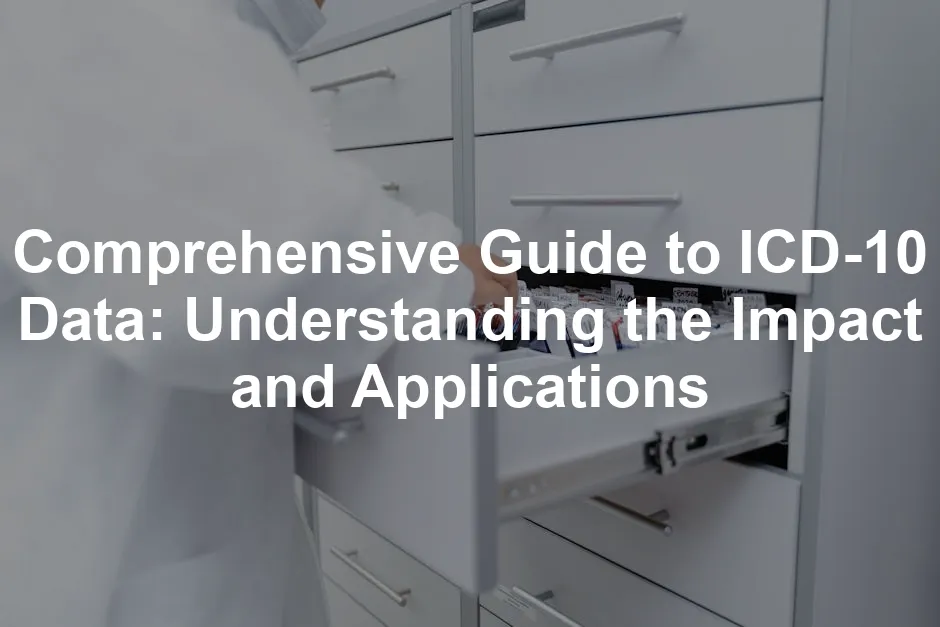Introduction
ICD-10 data plays a crucial role in healthcare coding and billing. It enhances the accuracy of patient records and streamlines billing processes. The transition from ICD-9 to ICD-10 marked a significant upgrade in coding capabilities. This change allowed for more specific and detailed coding of diseases. Consequently, it improves patient care and supports better statistical analysis.
If you’re looking to dive deeper into the world of medical coding, check out the ICD-10-CM and ICD-10-PCS Coding Manual. It’s like having a cheat sheet for the world of medical coding.
Summary and Overview
ICD-10 data consists of two main components: ICD-10-CM and ICD-10-PCS. ICD-10-CM focuses on diagnosis codes, while ICD-10-PCS covers procedure codes. These codes document medical diagnoses and procedures, ensuring accurate communication among healthcare providers and insurers. Precise coding is vital for patient treatment and reimbursement processes. The ongoing updates to ICD-10 codes reflect the evolving healthcare landscape. Looking ahead, the transition to ICD-11 is on the horizon, promising even more detailed coding options.
ICD-10, or the International Classification of Diseases, Tenth Revision, serves as a global health data standard. It has been adopted by many countries for consistent tracking of health data. Currently, over 117 countries utilize ICD-10 for various healthcare applications. Approximately 80% of healthcare providers in the United States have adopted ICD-10 codes, demonstrating its widespread impact. This system not only supports healthcare data management but also enables public health tracking and research.

Accurate coding is essential for effective healthcare delivery and management. It ensures that providers receive appropriate reimbursement and that patients receive quality care. As healthcare continues to advance, staying informed about coding practices and updates is crucial for all professionals involved.
For those looking to brush up on their coding knowledge, the Medical Coding for Dummies is a fantastic resource. It’s like having a personal tutor who doesn’t judge you for asking the same question twice!
For those interested in enhancing their understanding of healthcare analytics, it’s beneficial to explore the top methods for calculating class boundaries in statistics for healthcare analytics.
Understanding ICD-10 Codes
What is ICD-10?
ICD-10, or the International Classification of Diseases, Tenth Revision, serves as a critical coding system in healthcare. Its primary purpose is to categorize diseases, conditions, and health-related issues consistently across various settings. The structure of ICD-10 is comprehensive, featuring over 14,000 codes that allow for precise classification.
ICD-10 codes are organized into chapters and categories. Each chapter covers a specific type of disease or health issue, such as infectious diseases or mental disorders. This organization ensures that healthcare providers can quickly find the appropriate code for any diagnosis. For example, Chapter I addresses infectious and parasitic diseases, while Chapter II covers neoplasms.

Specificity in coding is essential. Detailed codes provide a clearer picture of a patient’s condition, allowing for better treatment plans and accurate billing. The increased granularity of ICD-10 compared to its predecessor, ICD-9, enhances the quality of health data. This specificity not only aids in patient care but also supports public health research.
Overall, the transition to ICD-10 reflects evolving healthcare standards, improving communication between providers and insurers. It emphasizes the importance of accurate diagnosis classification, ultimately leading to better patient outcomes. With a robust system in place, healthcare professionals can stay informed and responsive to the needs of their patients.
To further enhance your understanding, the ICD-10-CM Code Book is a must-have. It’s like having a personal GPS for navigating the coding highways!
The Role of ICD-10 Data in Healthcare
Importance of Accurate Coding
Accurate ICD-10 coding is vital for healthcare providers. It directly impacts reimbursement rates and overall healthcare quality. When codes are precise, insurers can process claims more efficiently. This means providers receive payments on time, ensuring financial stability.

Moreover, coding accuracy influences patient care significantly. It allows healthcare professionals to develop tailored treatment plans based on exact diagnoses. Using precise codes, providers can track patient outcomes more effectively. This drives improvements in healthcare analytics and public health initiatives.
For instance, statistics show that a 95% coding accuracy can lead to a 20% increase in reimbursement rates. Inaccurate codes, on the other hand, can result in claim denials and delayed payments. This highlights the importance of proper training in medical billing practices to ensure high-quality patient care.
ICD-10 data also plays a crucial role in public health research. By analyzing trends in disease coding, researchers can identify emerging health issues. This information is essential for developing effective health policies and interventions. Overall, accurate coding is a cornerstone of effective healthcare delivery and management.
To ensure you’re always prepared, consider investing in a First Aid Kit. You never know when a coding emergency might arise!
Updates and Changes in ICD-10
Recent Developments
ICD-10 codes undergo regular updates to remain relevant. Recently, new codes have been introduced to address emerging health concerns, especially those related to infectious diseases. For example, the addition of codes for COVID-19 variants reflects the ongoing pandemic’s impact on healthcare.
The process for updating codes involves careful review and collaboration among healthcare experts. Each year, organizations like the CDC and CMS release new coding guidelines. Keeping track of these changes is crucial for health professionals to ensure compliance.

Currently, there are over 41 new codes introduced for the upcoming fiscal year. Staying informed about these updates helps providers maintain accurate records and optimize billing. Resources such as official websites offer tools for tracking these changes effectively.
Understanding these developments is essential for all healthcare providers. By staying current with ICD-10 guidelines, professionals can enhance their coding accuracy and improve patient care. Regular education and training will help navigate this complex landscape, ensuring they remain compliant and efficient.
Enhance your skills with the Medical Coding Workbook for ICD-10-CM. It’s the perfect companion to solidify your knowledge and skills!
Future of ICD Coding: Transition to ICD-11
Preparing for ICD-11
The transition to ICD-11 is approaching, and it will bring significant changes. This new coding standard aims to improve health data accuracy. Healthcare providers need to prepare for this shift.

One major difference between ICD-10 and ICD-11 is the number of codes. ICD-11 includes over 55,000 codes, compared to ICD-10’s 14,000. This expansion allows for more precise documentation of health conditions. Additionally, ICD-11 offers enhanced digital tools for better data sharing.
The timeline for this transition is set for January 1, 2022. Many countries are already in various implementation phases. For example, as of May 2024, 132 member states are working on integrating ICD-11. Some are even conducting pilot programs.
Healthcare providers should utilize available resources to ensure a smooth transition. Training programs and webinars are essential for understanding the new coding framework. Websites like ICD10Data.com provide valuable reference materials. Staying informed will help mitigate coding errors and improve patient care.

As we move forward, embracing these new coding standards will be crucial. The ICD-11 transition represents a leap toward more effective healthcare management. By preparing now, providers can navigate this change confidently and efficiently.
Make sure you’re equipped for whatever comes next with a reliable Digital Thermometer. It’s essential for monitoring health trends!
FAQs
What is the main purpose of ICD-10 codes?
ICD-10 codes serve to document medical diagnoses and procedures. They provide a standardized way to classify diseases and health conditions. This ensures clear communication among healthcare providers and insurers. Accurate coding is vital for effective patient treatment and reimbursement processes. By using these codes, healthcare professionals can track patient outcomes and improve care quality.
How often are ICD-10 codes updated?
ICD-10 codes are updated regularly, typically once a year. The updates include new codes, revisions, and deletions. Healthcare professionals can stay informed by checking official websites like the CDC and CMS. Email subscriptions for updates are also a great way to remain current. Keeping up with these changes helps ensure compliance and accuracy in coding.
What are the differences between ICD-10-CM and ICD-10-PCS?
ICD-10-CM and ICD-10-PCS serve different purposes. ICD-10-CM focuses on diagnosis codes used in outpatient settings. In contrast, ICD-10-PCS is used for procedure coding in inpatient settings. Each system has specific rules and structures. Understanding these distinctions is crucial for accurate coding and billing.
Why was the transition from ICD-9 to ICD-10 necessary?
The transition from ICD-9 to ICD-10 was essential due to ICD-9’s limitations. ICD-9 had fewer codes, making it difficult to capture detailed data. ICD-10, with its expanded code set, allows for more specificity. This change improves data accuracy, enhances patient care, and supports better health statistics. Overall, the upgrade reflects the need for more comprehensive healthcare documentation.
What resources are available for learning ICD-10 coding?
Many resources help individuals learn ICD-10 coding. Websites like ICD10Data.com offer free tools for quick code lookup. Additionally, AAPC provides training programs and certification options. Online courses and webinars are also valuable for understanding coding practices. Utilizing these resources can enhance coding skills and knowledge significantly.
If you’re serious about coding, consider adding a Medical Terminology: A Short Course to your arsenal. It’s a quick way to boost your vocabulary without breaking a sweat!
Please let us know what you think about our content by leaving a comment down below!
Thank you for reading till here 🙂
All images from Pexels




